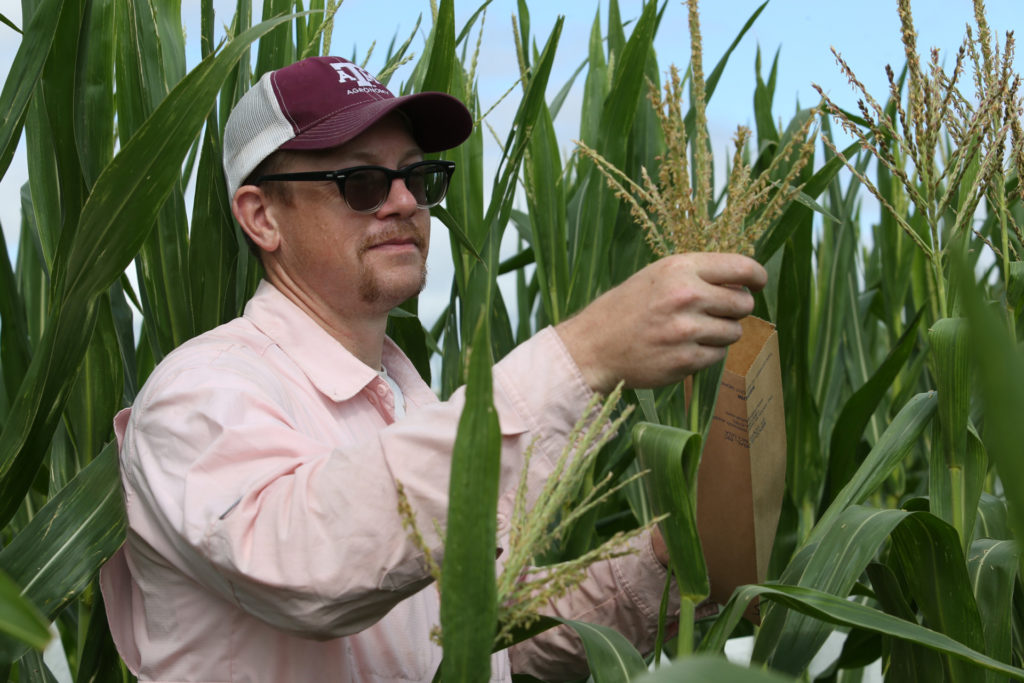AgriLife research expected to improve predictions on plant growth
$3 million grant assists in phenotyping research
With the help of a new $3 million grant from the U.S. Department of Agriculture’s National Institute of Food and Agriculture, Texas A&M AgriLife researchers will collaborate to elevate phenotyping for plant science and improving plant growth predictions.
Seth Murray, Ph.D., Texas A&M AgriLife Research corn breeder and Butler Chair, and Amir Ibrahim, Ph.D., Regents Professor and AgriLife Research small grains breeder and geneticist, both in the Department of Soil and Crop Sciences at Texas A&M University, Bryan-College Station, have orchestrated a team of collaborators to continue research started at Texas A&M. The research uses the corn Genomes to Fields, G2F, Initiative and high-throughput phenotyping of wheat yield-related traits and foliar disease resistance to increase efficiency and gain.

Improving plant phenotyping
Throughout the life of the project, Murray and Ibrahim, along with fellow researchers from Texas A&M and the University of Nebraska-Lincoln, anticipate making leaps in the science and engineering of plant phenotyping. Some of these include new sensor/tool development, data modeling and analytics, and workforce development.
The grant has four over-arching goals and aims to support two ongoing community-based plant phenotyping efforts at both University of Nebraska-Lincoln and Texas A&M. It will primarily focus on the corn Genomes to Fields Initiative, an initiative to interpret corn genomic information for the benefit of growers, consumers and society, and the winter wheat breeding programs.
The grant will advance and apply the use of unoccupied aerial vehicles, UAVs or drones, as a platform for data collection of plant physiological and biochemical traits at leaf and canopy levels.
“In other words, how can we use UAVs as tools to understand, monitor and manage crops. Along with this, the project will focus on development of new types of sensors and tools to develop precise and consistent systems and protocols, enabling high-throughput analysis,” Murray said.
The grant will disseminate phenotyping data broadly and promptly via public data repositories and create image processing and analytical tools that provide end-to-end solutions to extract target traits from UAV images. These public data releases will provide computer scientists and remote-sensing experts a dataset from which they may test new algorithms and techniques. It will also assist in training the next generation workforce in high-throughput plant phenotyping through graduate and undergraduate research and by developing in-class curriculum, online educational material, and summer short-term training workshops.

Further research for plant improvement
For the corn work in Bryan-College Station, the team will create three treatments to look at and compare how genetics perform under three conditions: optimal, late-planted heat stress and dryland, or drought stress, Murray explained.
“G2F is the largest cooperative study of corn genetic diversity and performance across the U.S. with around 30 locations; the goals of G2F are to connect genotype to phenotype specifically looking at genetic-by-environmental interactions,” Murray said.
Leveraging this resource, the team uses UAVs twice a week to collect images from which they can measure various phenotypes of the plants.
Ibrahim utilizes sensors mounted on drones as well as ground-truthing equipment to collect data on advanced trials and hybrids over spatial and temporal resolutions.
“Most of what we do in terms of applied research is designed to help our breeding efforts,” Ibrahim said. “As we invest more and more into this technology, we will be better positioned to develop high-yielding and resilient varieties without compromising end-use quality characteristics.”
Predicting plant performance
Murray said information from previous UAV work has been and will continue to be made publicly available, creating the largest such public dataset of its kind and allowing data scientists to develop improved analysis methods
“From our preliminary analysis, we have discovered that we can predict performance much earlier in growth than ever believed previously; this is very helpful for our plant breeding efforts,” he said.
The features discovered to be important by UAVs related to crop health could also be directly applicable to farmers in managing their crops.
“For phenotyping, this grant will not just provide reference datasets that can be used to develop tools for improved selection criteria but also to discover new biological insights,” Murray said. “Phenomic-selection approaches are being developed as a tool that can use phenotypic measurements for the appearance of plants, the way random genetic markers are used in genomic selection. The data sets collected under this project will be key to confirming this approach and the important features might be useful for agronomic management.”
The use of high-throughput image-based selection has become an integral part of the team’s resources similar to high-throughput genotyping and end-use quality evaluation.
“It is a tool that will increase our efficiency and gain from selection, and we are investing considerable time and effort into it,” Ibrahim said.
With these results, the team hopes to use these techniques to estimate yield, yield-related traits and crop quality in the future.
“The areas of phenotyping using remote sensing and phenomics will likely become as important or more important than genomics in plant improvement and biological discovery, but this area is currently 30 years behind genomics,” Murray said. “This study will be instrumental in catapulting phenomics forward.”


